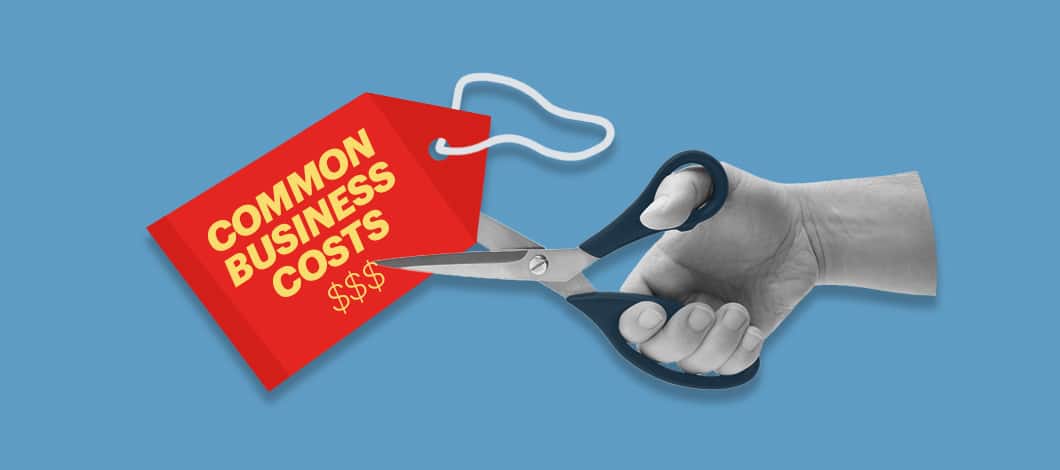Managing common business expenses is a key to successful financial planning. Here’s our guide to keeping your biggest costs down.
We’ll start by looking at what qualifies as a business expense and what the main expense categories are. Then we’ll list some of the most common business expenses, with an emphasis on items that have increased in importance since the outbreak of the COVID-19 pandemic. As we examine each item, we’ll offer some tips for cutting costs.
What Qualifies as a Business Expense?
For tax deduction purposes, the Internal Revenue Service defines business expenses in terms of items that involve the ordinary and necessary cost of running a company. An ordinary expense is one that is common and accepted in your line of business. For example, the cost of producing goods is a normal expense for a manufacturing company.
A necessary expense is one that is helpful or appropriate for running a business, even if it isn’t strictly indispensable. For example, internet marketing is helpful for generating sales, even though it’s possible to generate sales through other means.
Understanding the concept of ordinary and necessary expenses can help you claim deductions and reduce your tax expenses. Additionally, it can aid you in understanding the expense categories listed on your financial statements.

Business Expense Categories
Accountants divide major expense categories for small businesses into operating expenses, nonoperating expenses and capital expenses:
- Operating expenses are monthly business expenses involved in running daily operations related to your core business functions
- Nonoperating expenses are other periodic expenses not related to running daily core operations, such as interest payments on debt, losses on sale of assets and one-time expenses such as legal fees
- Capital expenses involve long-term business investments such as purchases of commercial real estate
- Capital expenses usually are handled separately because they require special accounting procedures. Accountants similarly may factor out nonoperating expenses to focus on core business operations. Accordingly, most common business expenses pertinent to cost-cutting strategies fall into the operating expenses category.
Types of business expenses that fall under operating expenses include:
- Cost of goods sold (cost of sales): expenses directly involved in producing goods, such as costs of material and labor directly used in production
- General and administrative costs: expenses not involved in the cost of producing specific products, such as salaries of managers, wages of employees not involved in production
- Selling costs: expenses associated with sales and associated activity such as marketing and shipping
- Depreciation or amortization: expenses associated with long-term costs of tangible assets such as equipment and intangible assets such as intellectual property
- Research and development: expenses associated with innovation
This business expense categories list serves as a structure for organizing items that appear on your company’s profit-and-loss statement, also known as your income statement. Cost of goods sold is listed immediately below revenue and subtracted from it to calculate gross profit. Then other expenses are subtracted to calculate net profit.
A Strategic Business Expenses List
When it comes to cost-cutting strategies, it pays to focus on the most expensive items on your small business expenses list. While specifics vary by industry and company, certain items such as payroll typically lead the list of most costly items for business expenses. The pandemic has increased expenses for certain items, such as digital transformation.
Here’s a list of some typical common business expenses along with some strategies for reducing each.
Payroll
Payroll costs, always a major company expense for businesses, have risen in the wake of the pandemic and interrelated labor shortage, supply chain and inflationary trends. With the job market shaken by the pandemic, workers are quitting their jobs in droves, creating a job shortage which puts wages on track to increase 4% to 4.5% annually, said Michael Pearce, a senior U.S. economist for economic research consultancy Capital Economics quoted in The Washington Post.
Meanwhile, prices surged 5.4% in September compared with a year earlier, marking the highest inflation rate since the height of the Great Recession in 2008, according to Bureau of Labor Statistics data. The scarcity of workers, coupled with rising prices, puts payroll costs on a track to continue climbing.
Strategies for reducing payroll costs include:
- Focusing on employee retention to reduce turnover and recruitment costs
- Allowing employees to work remotely
- Trading off benefits such as flexible hours for wages
- Reducing benefits such as matching 401(k) programs
- Outsourcing noncore tasks
- Automating repetitive processes
For many employers, using these types of strategies to reduce payroll costs will go a long way toward trimming operating expenses.
Rent
Office rental costs have felt the impact of the pandemic. Initially, as lockdowns and remote work slowed down on-site operations, demand for office space fell, sending rental costs down. Then as workers began returning to the office, demand for office space rose again for the 9 months leading up to September 2021.
All core U.S. commercial real estate markets experienced a fall in demand by 13%-23% from August to September, according to the VTS Office Demand Index, an industry indicator of office rental activity, as summarized by commercial real estate site GlobeSt. New office demand in remote-friendly cities such as San Francisco sits at half of its pre-pandemic average.
Strategies for cutting rental costs include:
- Taking advantage of current low demand to renegotiate leases at lower rates
- Relocating to less expensive office space
- Downsizing on-site office space by making more efficient use of floor space
- Shifting some on-site operations to a virtual infrastructure
The last pair of strategies can work well together within the context of a digital transformation strategy that utilizes a remote workforce and virtual office environment.
Utilities
Another major cost associated with office space is utilities. According to data from the U.S. Energy Information Administration, commercial electricity use led by:
- Lighting
- Refrigeration
- Ventilation
- Cooling
- Computers
Strategies for reducing utility costs include:
- Using energy-efficient appliances certified by the Environmental Protection Agency and the U.S. Department of Energy’s ENERGY STAR program
- Installing energy-efficient light bulbs
- Using motion-activated smart lighting
- Using smart thermostat systems
- Setting computers to go into sleep mode when not in use
- Shifting your technology infrastructure to the cloud
Arranging a commercial energy audit can help you identify your biggest sources of energy consumption and develop strategies to reduce your costs.
Cost of Goods Sold
If you manufacture or sell physical products, your costs of goods sold can form a significant part of your expenses. Inflationary trends and supply-chain woes are sending costs of goods up. Steps you can take to reduce cost of goods sold include:
- Focusing production on profitable items
- Shifting to digital products
- Substituting lower-cost materials
- Outsourcing labor
- Shopping suppliers
- Buying at bulk discount rates
- Using automation to streamline production
Work with your accounting professional to identify which components are contributing the most to your cost of goods sold, such as materials or labor. Focus your cost-cutting strategies where they will have the greatest effect.
Minimize Your Small Business Expenses to Maximize Your Profits
Business expenses encompass costs that are ordinary and necessary for running a company in your industry. From an accounting perspective, these break down into operational, nonoperational and capital expenses. Areas where cost-cutting strategies can be applied to operational expenses include payroll, rent, utilities and cost of goods sold.
To gain the most benefit from applying cost-cutting strategies, work with your accounting professional to identify your biggest business expenses and focus on the items which will save you the most money. Applying these guidelines can help you shrink your costs and expand your profit margin.











